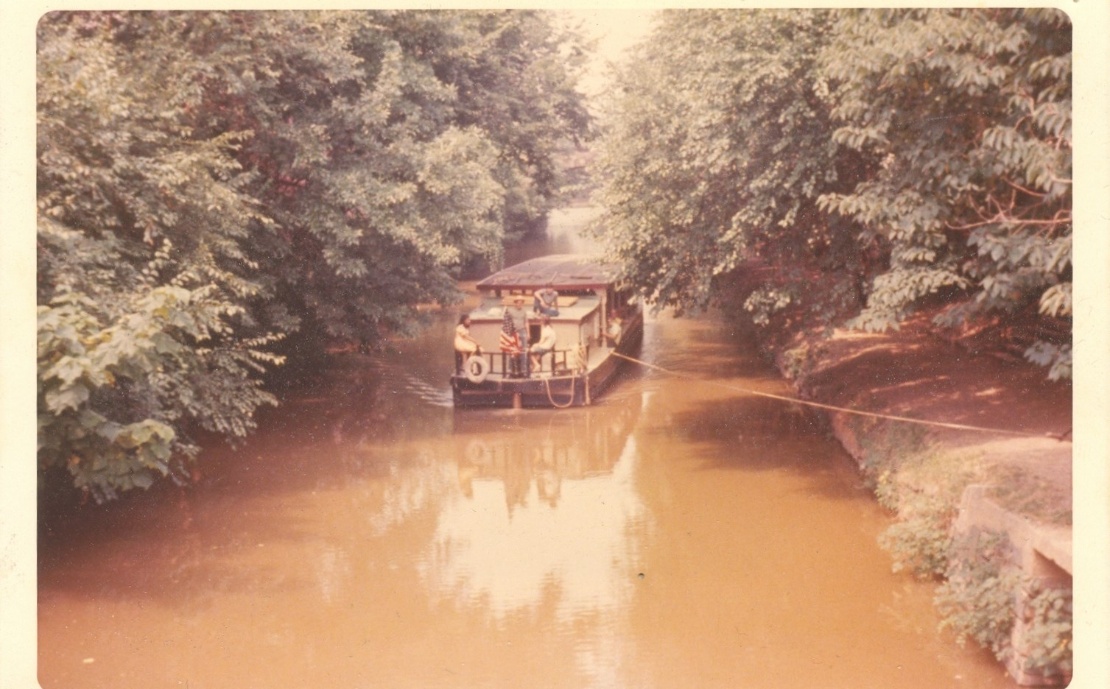The Towpath

I wrote about being a summer kid on Cape Cod in some past ruminations. Summers seem to be my most memorable times. The summer after high school graduation, I lived on our 46 foot bay-built boat Tai-Pan in the Patuxent Naval Air Station marina on Chesapeake Bay. It was a great treat and almost like having your own apartment. Being independent, cooking your own food, working on the boat and staying up half the night couldn’t have been more fun for the newly minted graduate. I would fish from the boat catching eel and some of those delicious Chesapeake blue crabs. Boiling crabs on the dock and adding some corn on the cob made a meal almost like our famous New England clam bake (lobsters, corn, potatoes and steamers!) It is a lot more work to pick meat from a crab than a lobster, but the same basic principles apply.
Our ancestors worked with animals to make their living; I’ve seen pictures of men with horse-drawn wagons emptying fish weirs at low tide. Oxen were used as the power source to drive piles into the sea floor to build piers and they were also used to move houses. I spent two summers working with barge mules on the Chesapeake and Ohio (C&O) Canal in Washington, D.C. Unfortunately, I didn’t spend all my summers on the Cape but at least I was never far from the water with any of my work.
The Chesapeake & Ohio Canal was built in the early 1800s to connect Washington, D.C. to Pittsburgh, PA because the Potomac River is not navigable above the Great Falls, Virginia. Railroads did not yet exist and the Erie Canal had already proved to be an economic success. The C&O canal would provide a link from the Chesapeake Bay to the Ohio River. The canal was built beside the Potomac River, its water source. There was a twelve-foot-wide towpath at the edge of the canal and the canal was about 60 feet wide. Families lived on their 90 foot long barges in a 12 x 12 foot cabin in the stern of the vessel. The mules had their own cabin in the bow. Our interpretative barge was an exact replica of cargo barges but we had benches for tourists to sit where the cargos of lumber and coal would be stored. A barge could carry 100 tons of coal.
This canal was an amazing engineering feat. There was one point where barges had to traverse a 3,000-foot long tunnel. In other areas the terrain was so rough that aqueducts had to be built to cross ravines. In fact, there was an aqueduct to take barges across the Potomac River from Washington to Alexandria where the sailing ships would dock and transfer their cargos. The canal was 185 miles long and the family worked 12-18 hours a day going about three miles an hour. At this rate you could manage the distance from Cumberland, Maryland (Harper’s Ferry) to Washington in about seven days.
Mules do not work alone on the towpath; someone has to walk with them. If you try to keep up a three-mile per hour pace all day you will have had a workout. The mules are hitched up in-line, one in front of the other, instead of in tandem (side-by-side). Our mules were named Dick and Kate. Kate was larger so she was always in back, the anchor mule, with the tow-rope hooked to the wiffle tree of her harness. If the barge captain doesn’t maintain the barge position correctly, that 100 tons of coal could pull the mules right into the water. Mules are the smartest animals I have ever worked with. (Well actually, the only animals I’ve ever worked with). Dick knew that if he would back off one-half step from the pace, his traces would slacken just enough to make his walk easier. Kate knew that if it suddenly seemed her load was increasing, that Dick was a slacker and she would bite him on the butt. I never had to worry about Dick because Kate would keep him in line.
I only walked about five miles of towpath during my trick or half-day of work with my two-a-day tourist cruises. If I was lucky, the park ranger would take a break and I would give the tourist spiel about the canal construction and how the muskrats would dig their burrows in the canal wall and cause breaches that the lock-keepers would have to repair. I also spent my time on the tiller. A barge has a six-foot tiller attached to a barn door-sized rudder, and I could turn that baby around at the end of our tour on a dime. There was no problem knowing where the turn-around point was because Dick and Kate had it memorized. They would not pull the barge past that point. They just waited for the hands to get the barge turned around, tow-rope passed from one side of the boat to the other and then start the long pull back home.
If it had rained recently, Dick would always make a small detour on the towpath to splash through the puddles. As the water splashed up, it must have felt very cool on his belly because he made a big scene. As we neared the start point the canal was very narrow, so we turned the barge around again and were towed backwards for about 1000 yards. It is a supreme trick to keep that barn door rudder from slamming to one side or the other when being towed backwards with all that water pressure working against you, but luckily, I never lost control of it. Now two mules cannot pull a 100 ton barge all day. A spare set of mules was kept on the bow of the barge, which were swapped every six hours or so. In our case, on weekends we made three trips a day which would be too much for Dick and Kate to handle alone, so we had a relief mule. Red, a retired Army red mule, was so huge, he could pull the tourists all by himself. It is interesting that a mule will not drink water until he finishes his daily work. How would you like to walk 20 miles with a belly full of water sloshing around? So between trips, they would not drink even when you put the bucket in front of them. But at the end of the day, right before being loaded on the trailer, they would suck down that water like there was no tomorrow. Horses are not nearly this smart and have nowhere near the stamina of a mule.
There are 74 locks on the C&O canal and they raised or lowered barges nearly ten feet each time. In between locks the three or four-mile stretch of canal and towpath are perfectly level. Water will not have it any other way. There is very little current in the canal so it didn’t matter whether you were pulling east or west. At the start of each trip, we hauled the barge into one of the original 100 foot-long locks, closed the gates and opened the sluice. You can raise 100 tons of barge, tourists and all, ten feet in only ten minutes.
I always warned tourists in the front of the barge they might get wet when I let the water into the lock. At the end of the trip, we lowered the barge back to its starting point by just pulling the plug and letting the water drain out of the lock. It was the job of the Potomac River to supply enough water to lower the boats and keep the muskrats happy. River, man and mule were an amazing partnership. These animals were usually well cared for since the lifestyles of a small family barge business depended on their well-being.
I hope this story has given you a little insight into the use of animals as the machinery of life. We’ve all got these kinds of stories running around in our heads. You know your children, grandchildren and friends would greatly appreciate hearing your tales. How about spending time, just a couple of days a week recording some of these mental treats for the rest of us?
1972

To leave a comment, please Signin or Register.